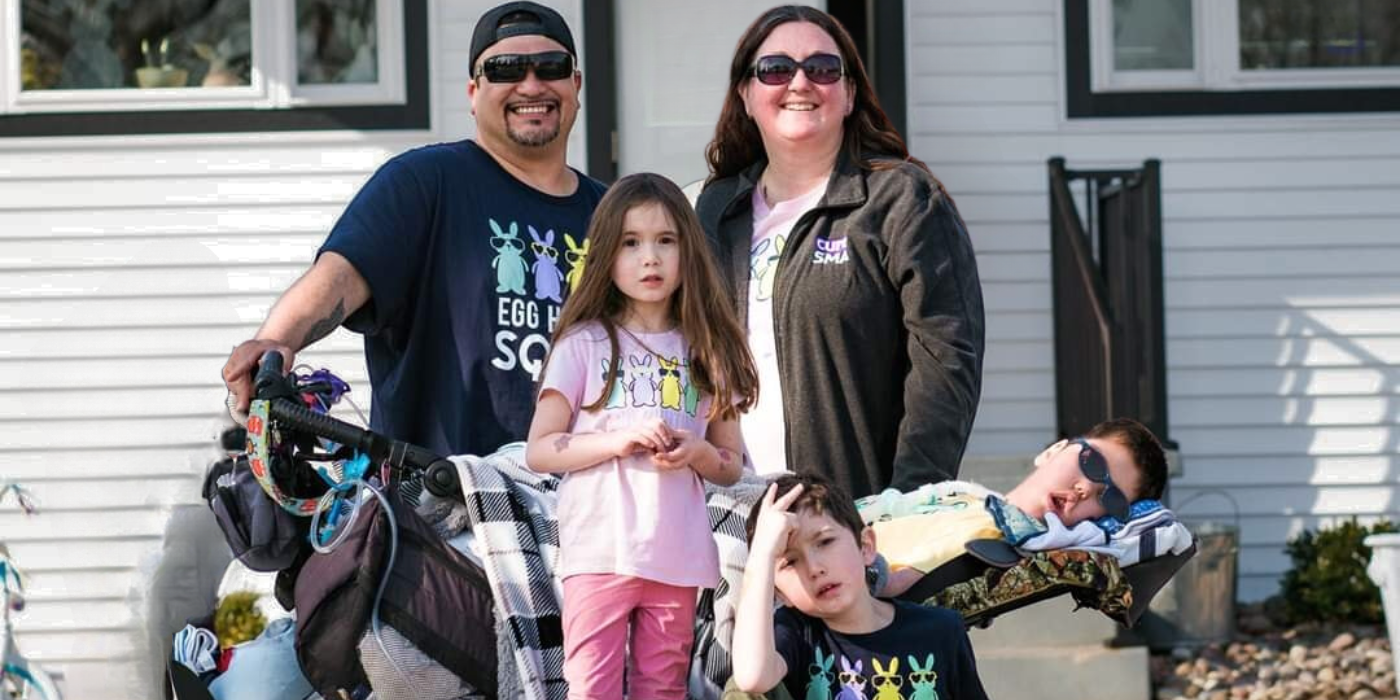A Dozen Years Since Diagnosis: The Evolution of SMA

Amy and Adan Medina have three kids, each diagnosed with spinal muscular atrophy (SMA), a rare genetic disorder. And the prognosis for the most severe types, when left untreated, is devastating—permanent ventilation or death by age two in 90% of cases.
“When I first heard about SMA, all I heard was a death sentence. Doctors told us, ‘We’re sorry, there’s nothing we can do. Go take your child home and love him with the time you have left.’ It was devastating. There was no hope,” explained Amy. “But my perspective of SMA has totally changed throughout the last 12 years.”
SMA is caused by a nonfunctioning or nonexistent survival motor neuron 1 (SMN1) gene, which is responsible for producing SMN protein. Without enough SMN protein, motor neuron cells throughout the body may lose function and die, leading to progressive muscle weakness, paralysis, permanent ventilation or death.
Today, Mateo, Javier and Amelia Medina, ages 12, seven and five respectively, are reaching their own milestones and defying the expectations of children with SMA every day. Each child was diagnosed with SMA and received treatment at different parts of their journeys.
“Because SMA results in progressive muscle loss, early treatment is extremely important for a child’s growth and development. The loss of motor neurons is irreversible,” said Dr. Sandy Reyna, Vice President of Global Medical Affairs, Head-Therapeutic Area at Novartis Gene Therapies.

Mateo and Javier both have SMA Type 1, one of the most severe forms of SMA. When Mateo was diagnosed, there were no treatment options available. He has relied on a tracheostomy to breathe since he was seven months old. He began treatment at age six. Javier was diagnosed in utero via amniocentesis and received treatment as an infant. In spite of their diagnosis, both boys are full of personality and life.
“We’ve seen Mateo crush SMA. I mean, we were told he wasn’t going to make it till his second birthday, and he’s starting middle school,” said Amy. “Javier is defying the odds too. He’s doing things he never should’ve been able to do as a Type 1, like walk on his own.”
Amelia, the youngest Medina, was diagnosed in utero via amniocentesis just like Javier. When Amelia was born, the Medinas decided on another treatment route, enrolling her in a clinical trial for Zolgensma® (onasemnogene abeparvovec-xioi)—in which she was treated at eleven days old.
Zolgensma is the only one-time gene therapy for SMA and the only treatment to address the genetic root cause of SMA by replacing the function of the nonfunctioning or nonexistent SMN1 gene with a single dose. Zolgensma can increase liver enzyme levels and cause acute serious liver injury or acute liver failure which could result in death. In clinical trials, the most common side effects were elevated liver enzymes and vomiting. Please see additional Important Safety Information below and accompanying Full Prescribing Information. Children treated with Zolgensma need to receive an oral corticosteroid starting the day before infusion, and then after infusion for about two months or longer depending on their liver function exams and labs. Children treated with Zolgensma also need baseline labs and then need to return for blood tests weekly, bi-weekly and then monthly for at least the first three months after treatment.
“Zolgensma is designed to address the genetic root cause of SMA in a single dose. It stops disease progression,” explained Dr. Reyna.
Amelia—who prefers to be addressed as “princess”— shows no signs of SMA at age five. She has not received any additional treatment.
Nowadays, she spends her days running and jumping at full-day kindergarten.
“Being able to watch her with kids her age really showed that she is progressing at the same rate as them. She’s thriving,” shared Amy. “I have to remind myself that she does have SMA even though she has no symptoms.”
From Mateo’s diagnosis to Amelia’s, the world of SMA has changed in front of Amy’s eyes.
“Seeing how science and medicine have evolved is incredible,” said Amy. “Being newly diagnosed is entirely different than it was years ago. Twelve years ago, I would have never in my life thought I’d see a child with SMA who is like Amelia. SMA is not a death sentence now. Families still need support, but now there’s more hope.”

Results and outcomes vary among children based on several factors, including how far their SMA symptoms progressed prior to receiving treatment.
Indication and Important Safety Information for ZOLGENSMA® (onasemnogene abeparvovec-xioi)
What is ZOLGENSMA?
ZOLGENSMA is a prescription gene therapy used to treat children less than 2 years old with spinal muscular atrophy (SMA). ZOLGENSMA is given as a one-time infusion into a vein. ZOLGENSMA was not evaluated in patients with advanced SMA.
What is the most important information I should know about ZOLGENSMA?
• ZOLGENSMA can increase liver enzyme levels and cause acute serious liver injury or acute liver failure which could result in death.
• Patients will receive an oral corticosteroid before and after infusion with ZOLGENSMA and will undergo regular blood tests to monitor liver function.
• Contact the patient’s doctor immediately if the patient’s skin and/or whites of the eyes appear yellowish, if the patient misses a dose of corticosteroid or vomits it up, or if the patient experiences a decrease in alertness.
What should I watch for before and after infusion with ZOLGENSMA?
• Infections before or after ZOLGENSMA infusion can lead to more serious complications. Caregivers and close contacts with the patient should follow infection prevention procedures. Contact the patient’s doctor immediately if the patient experiences any signs of a possible infection such as coughing, wheezing, sneezing, runny nose, sore throat, or fever.
• Decreased platelet counts could occur following infusion with ZOLGENSMA. Seek immediate medical attention if the patient experiences unexpected bleeding or bruising.
• Thrombotic microangiopathy (TMA) has been reported to generally occur within the first two weeks after ZOLGENSMA infusion. Seek immediate medical attention if the patient experiences any signs or symptoms of TMA, such as unexpected bruising or bleeding, seizures, or decreased urine output.
• There is a theoretical risk of tumor development with gene therapies such as ZOLGENSMA. Contact the patient’s doctor and Novartis Gene Therapies, Inc. (1-833-828-3947) if a tumor develops.
What do I need to know about vaccinations and ZOLGENSMA?
• Talk with the patient’s doctor to decide if adjustments to the vaccination schedule are needed to accommodate treatment with a corticosteroid.
• Protection against influenza and respiratory syncytial virus (RSV) is recommended and vaccination status should be up-to-date prior to ZOLGENSMA administration. Please consult the patient’s doctor.
Do I need to take precautions with the patient’s bodily waste?
Temporarily, small amounts of ZOLGENSMA may be found in the patient’s stool. Use good hand hygiene when coming into direct contact with patient body waste for one month after infusion with ZOLGENSMA. Disposable diapers should be sealed in disposable trash bags and thrown out with regular trash.
What are the possible or likely side effects of ZOLGENSMA?
The most common side effects that occurred in patients treated with ZOLGENSMA were elevated liver enzymes and vomiting.
The safety information provided here is not comprehensive. Talk to the patient’s doctor about any side effects that bother the patient or that don’t go away.
You are encouraged to report suspected side effects by contacting the FDA at 1-800-FDA-1088 or
www.fda.gov/medwatch, or Novartis Gene Therapies, Inc. at 1-833-828-3947.
Please see the Full Prescribing Information.
© 2023 Novartis Gene Therapies, Inc.
Bannockburn, IL 60015
US-ZOL-23-0092 11/2023







